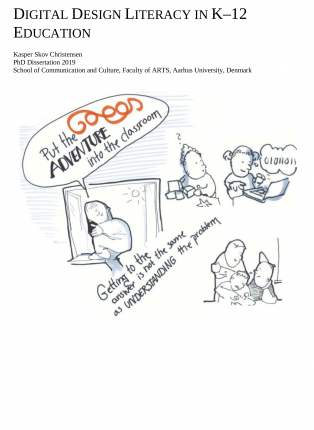Digital Design Literacy in K-12 Education
Nøgleord:
literacy, education, K-12, children, design, digital, technology, making in educationSynopsis
This dissertation addresses the introduction, sustainment and articulation of digital design literacy in K-12 education. It is the result of my four years of research in the FabLab@school.dk research and development project. Within this project, I have researched the topic through constructive design research experiments on both students’ and teachers’ experiences and competencies with digital design as new subject matter in K-12. The contributions presented in this dissertation are positioned within the emerging research field of making in education. The contributions concern new possibilities that making in education creates for K–12 students to develop competencies to design and critique digital technologies. The point of departure for my work was to explore how the implementation of maker settings and technologies might provide novel ways to combine constructionism, design and digital technology with the intention of having students develop digital design literacy. Hence, this dissertation is a response to the question of how to educate K–12 students to understand, use, critically reflect on, and design digital technologies through the emerging educational possibilities enabled by maker activities, maker settings, and maker technologies. The dissertation is comprised of five research papers and two reports framed by an overview that sum up the arguments made in the papers and the contributions from these come together as a whole.
The first contribution is a conceptual understanding of digital design literacy. I lay out a genealogy of traditional literacy toward new literacies to legitimize digital design as a new literacy in K–12 education. I contribute an understanding of how design and digital literacies are interrelated, can mutually benefit one another, and be synthesized and articulated holistically as integrated digital design literacy.
The second contribution are quantitative measures of the state-of-the-actual in terms of students’ digital, design, and critical literacy and an assessment tool for quantitatively evaluating students’ stance towards inquiry, which I argue to be an important competence of digital design literacy.
The third contribution is an understanding of three crucial aspects which must be considered when developing teachers’ capability to teach digital design literacy. I point to impediments for such teaching and to existing practicing teachers’ limited possibilities to meet demands presented by teaching digital design literacy. I contribute a framework for educating reflective design educators who can support students in developing digital design literacy.
The accumulation of these three contributions has resulted in what is the main contribution of this dissertation overview: The Digital Design Literacy Framework. The framework contributes a legitmaziation, articulation and operational definitions of digital design as a new literacy and its underlying competencies.

